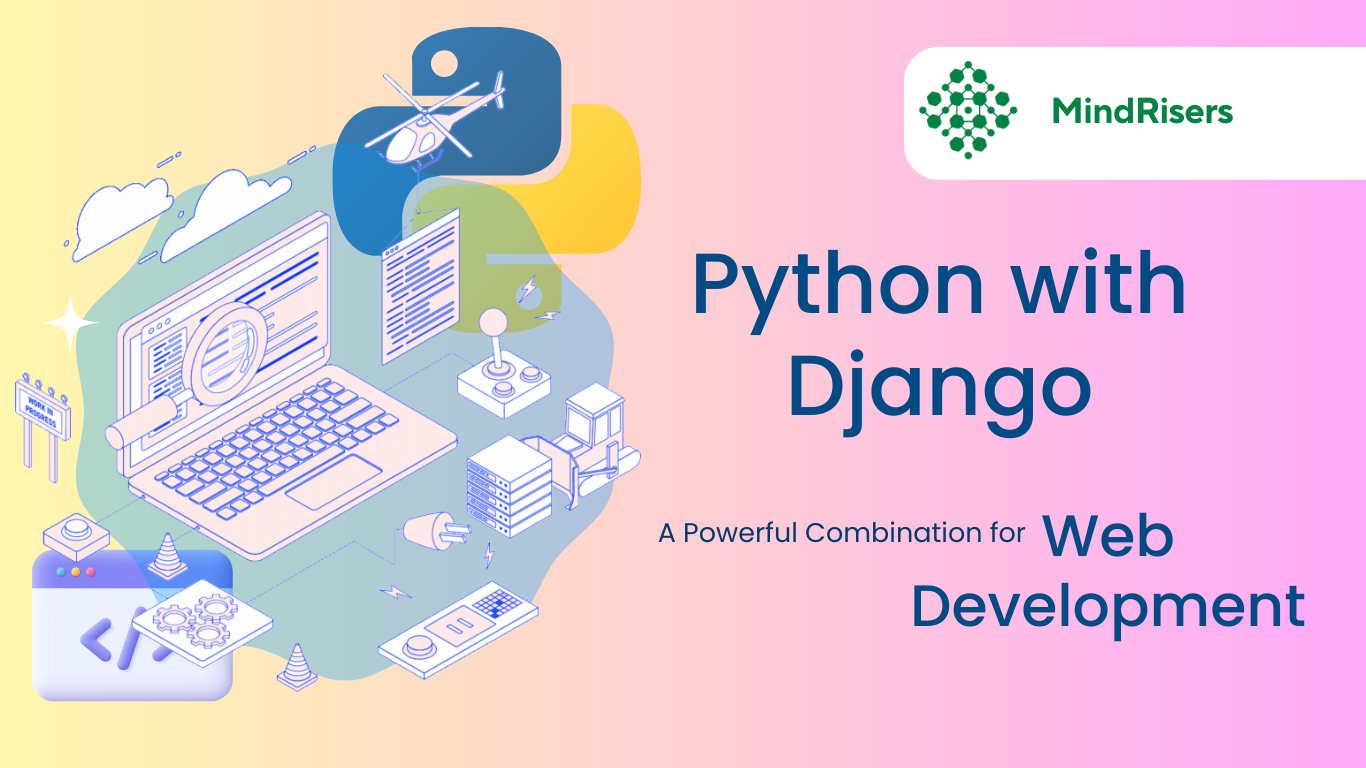
Bhushan Raj Shakya - Author
2023-07-06
Are you seeking to dive into the world of web development? Do you want to build dynamic and robust websites that can handle complex functionalities? Look no further! In this blog post, we will explore the powerful combination of Python with Django, a popular web development framework. With Python's simplicity and elegance and Django's versatility and efficiency, you can create amazing web applications that will leave a lasting impact. So let's embark on this exciting journey and discover the wonders of Python with Django!
1. Introduction to Python with Django
Python is a high-level, general-purpose programming language known for its readability and simplicity. It provides an excellent foundation for web development due to its clean syntax and extensive libraries. Django, on the other hand, is a powerful web framework written in Python that follows the model-view-controller (MVC) architectural pattern. It provides developers with a pragmatic approach to building web applications rapidly.
2. Getting Started with Python and Django
To begin your journey with Python and Django, you first need to set up your development environment. Follow these steps to get started:
1. Install Python: Visit the official Python website and download the latest version of Python for your operating system. Follow the installation instructions provided.
2. Install Django: Once Python is installed, open your command prompt and run the following command: `pip install Django`. This will eventually install Django and its dependencies.
3. Create a Django project: In your command prompt, navigate to the desired directory and run the command `django-admin startproject projectname`. Replace `projectname` with your desired name for your project.
4. Run the development server: Change into the project directory (`cd projectname`) and execute the command `python manage.py runserver`. This will start the Django development server, and you can view your application by visiting `http://localhost:8000` in your web browser.
3. Building Web Applications with Django
Django provides a structured approach to web development, making it easy to build robust and scalable web applications. Here are the basic steps involved in creating a Django web application:
1. Define your models: Django uses object-relational mapping (ORM) to interact with databases. Define your models using Python classes, and Django will automatically create the necessary database tables.
2. Create views: Views handle the logic of your web application. They retrieve data from the models and pass it to templates for rendering.
3. Design templates: Templates define the structure and layout of your web pages. Use Django's template language to dynamically render data from views.
4. Configure URLs: Map URLs to views using Django's URL configuration. Define URL patterns that match specific URLs and direct them to the corresponding views.
5. Run migrations: When you make changes to your models, run migrations to update the database schema accordingly. Django provides a convenient command-line interface for managing migrations.
4. Django's Powerful Features
Django offers a wide range of features that make web development a breeze. Some of its notable features include:
- **Admin Interface**: Django provides
an automatic admin interface for managing your application's data. It allows you to perform CRUD (Create, Read, Update, Delete) operations without writing any additional code.
- **Authentication and Authorization**: Django comes with built-in authentication and authorization systems, making it easy to handle user registration, login, and permission-based access control.
- **URL Routing**: Django's URL routing mechanism allows you to define clean and readable URLs for your web application. Both pattern matching and parameter capturing are supported.
- **Form Handling**: Django simplifies form handling by providing a powerful form API. It handles form validation, error messages, and data persistence effortlessly.
- **Caching**: Django includes a caching framework that improves the performance of your web application by storing frequently accessed data in memory or other cache backends.
5. Django and Database Integration
Django supports multiple databases, including PostgreSQL, MySQL, SQLite, and Oracle. It provides a consistent API for interacting with different database systems, allowing you to switch between databases easily. Django's ORM abstracts the complexities of database management and enables you to work with database records as Python objects.
6. Django for Rapid Prototyping
One of Django's strengths is its ability to facilitate rapid prototyping. With its built-in features and conventions, Django allows developers to focus on implementing core functionalities rather than reinventing the wheel. This makes it an excellent choice for startups and projects with tight deadlines.
7. Django's Scalability and Security
Django is known for its scalability and security features. It is designed to handle high-traffic websites and can scale horizontally by adding more servers. Additionally, Django incorporates numerous security measures, such as protection against common web vulnerabilities like cross-site scripting (XSS) and cross-site request forgery (CSRF) attacks.
8. Python with Django: The Perfect Match
Python's simplicity and readability, combined with Django's versatility and efficiency, make them a perfect match for web development. The ease of learning Python, coupled with Django's robustness, empowers developers to create sophisticated web applications with ease.
9. Mindrisers: Your Path to Success in Web Development
If you're ready to take your web development skills to the next level, Mindrisers is here to help. Mindrisers is a leading IT institution that provides paid internships and online training programs in Nepal, including comprehensive courses on Python with Django. Whether you're a beginner or an experienced developer, Mindrisers offers advanced courses that will enhance your skills and pave the way for a successful career in the IT industry. Visit Mindrisers to learn more and kickstart your journey today!
10. Conclusion
In conclusion, Python with Django is an unbeatable combination for web development. With Python's simplicity and Django's power, you can create dynamic, scalable, and secure web applications that meet the demands of today's digital world. Start your web development journey with Python and Django today, and unlock a world of endless possibilities.
Frequently Asked Questions
1. What is Django?
Django is a powerful web development framework written in Python. It follows the model-view-controller (MVC) architectural pattern and provides a pragmatic approach to building web applications.
2. Why should I choose Python with Django for web development?
Python with Django offers a winning combination of simplicity, versatility, and efficiency. Python's readability and Django's powerful features make development a breeze.
3. Is Django suitable for beginners in web development?
Yes, Django is beginner-friendly. Its clear documentation, extensive community support, and built-in features make it an excellent choice for those starting their web development journey.
4. What is Mindrisers?
Mindrisers is a leading IT institution in Nepal that offers paid internships and online training programs. They provide comprehensive courses on Python with Django and other in-demand technologies.
5. How can I learn Python with Django at Mindrisers?
Visit Mindrisers and contact us to explore the available courses and enroll in the Python with Django training program. Take the first step towards a successful career in web development.
Recent Post
View All
Generative Engine Optimization (GEO) in 2025 and beyond: A Complete Beginner-Friendly Guide
2025-12-02.704 Views
Complete Roadmap to Become a Full Stack Python Developer
2025-10-14.1105 Views
How Local Businesses in Nepal Can Use WhatsApp Marketing Effectively
2025-08-18.1720 Views
AI Tools Every Students Should Know in 2025
2025-08-18.1624 Views
Never miss an Opportunity !
Want to learn TOP 2025 IT Skills ?
We open IT skill classes Monthly in Design, Development, Deployment, Data etc.
Have something to Ask ?
get admission enquiry